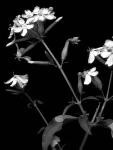 OTHER COMMON NAMES—Saponaria, saponary, common soapwort, bouncing-bet, soaproot, bruisewort, Boston pink, chimney-pink, crow-soap, hedge-pink, old maid's pink, fuller's herb, lady-by-the-gate, London-pride, latherwort, mock-gilliflower, scourwort, sheepweed, sweet-betty, wild sweet-william, woods-phlox, world's wonder.
OTHER COMMON NAMES—Saponaria, saponary, common soapwort, bouncing-bet, soaproot, bruisewort, Boston pink, chimney-pink, crow-soap, hedge-pink, old maid's pink, fuller's herb, lady-by-the-gate, London-pride, latherwort, mock-gilliflower, scourwort, sheepweed, sweet-betty, wild sweet-william, woods-phlox, world's wonder.
HABITAT AND RANGE—By one or another of its many common names this plant, naturalized from Europe, is known almost everywhere, occurring along roadsides and in waste places.
DESCRIPTION OF PLANT—Soapwort is a rather pretty herbaceous perennial, 1 to 2 feet high, and belonging to the pink family (Silenaceae.) Its smooth, stout and erect stem is leafy and sparingly branched, the leaves ovate, 2 to 3 inches long, smooth, prominently ribbed, and pointed at the apex. The bright looking, crowded clusters of pink (or in shady localities whitish) flowers appear from about June until far along in September. The five petals of the corolla are furnished with long "claws" or, in other words, they are narrowly lengthened toward the base and inserted within the tubular and pale green calyx. The seed capsule is oblong and one-celled.
DESCRIPTION of ROOT—Soapwort spreads by means of its stolons, or underground runners. But the roots, which are rather long are the parts employed in medicine. These are cylindrical, tapering toward the apex, more or less branched, and wrinkled lengthwise. The whitish wood is covered with a brownish red, rather thick bark and the roots break with a short, smooth fracture. It is at first sweetish, bitter, and mucilaginous, followed by a persistently acrid taste, but it has no odor.
COLLECTION, PRICES AND USES—As already indicated, the roots without the runners, should be collected either in spring or autumn. With water they form a lather, like soap, whence the common names soapwort, soaproot, latherwort, etc., are derived. The price ranges from 5 to 10 cents a pound. The roots are employed in medicine for their tonic, alterative and diaphoretic properties. The leaves are also used.
Ginseng and Other Medicinal Plants, 1936, was written by A. R. Harding.

